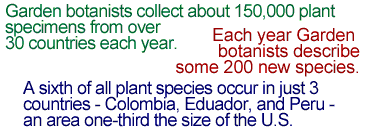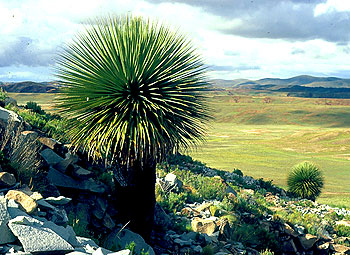 |
QUICK SEARCH
MO PROJECTS:
Africa
Asia/Pacific
Mesoamerica
North America
South America
General Taxonomy
Photo Essays
Training in Latin
America
MO RESEARCH:
Wm. L. Brown Center
Bryology
GIS
Graduate Studies
Research Experiences
for Undergraduates
Imaging Lab
Library
MBG Press
Publications
Climate Change
Catalog Fossil Plants
MO DATABASES:
W³MOST
Image Index
Rare Books
Angiosperm
Phylogeny
Res Botanica
All Databases
INFORMATION:
What's New?
People at MO
Visitor's Guide
Herbarium
Jobs & Fellowships
Symposium
Research Links
Site Map
Search
 |
table of contents |
 | |||
| In 1890, Albert Spear Hitchcock boarded a ship and launched an era of exploration. Traveling to the Caribbean, he became the first Garden staff member directly involved in collecting botanical specimens in the tropics. More than a century later, Hitchcock's adventurous spirit and hunger for knowledge live on through the Garden's global research program.
Botanists spend much of their time in the field, living and working in remote locations. Every year, Garden researchers collect about 150,000 plant specimens and describe about 200 new species. Discoveries in botany are rarely dramatic. Rather, they result from painstaking observation and research. Often, the collector doesn't really know what he or she has until it is studied in a laboratory and matched against botanical reference. Collaboration is the hallmark of the Garden's research program. Without exception, work is conducted in partnership with institutions in host nations - the overall goal is to strengthen their institutions and form partnerships that serve the needs of all. In several countries of exceptional biological importance - Bolivia, Costa Rica, Ecuador, Paraguay, Peru, Madagascar, and Vietnam - the garden maintains resident curators who live and work there. | |||
 In Bolivia, the Garden's resident botanist collaborates with local institutions to carry out explorations, floristic studies, and a botanical training program. Shown: Puya raimondii, Cerro Comanche, Bolivia. Photo: James Solomon |
|||
| Text and photos from "The Unseen Garden" available from MBG Press. | |||
© 1995-2025 Missouri Botanical Garden, All Rights Reserved
4344 Shaw Blvd.
St. Louis, MO 63110
(314) 577-5100
Technical Support